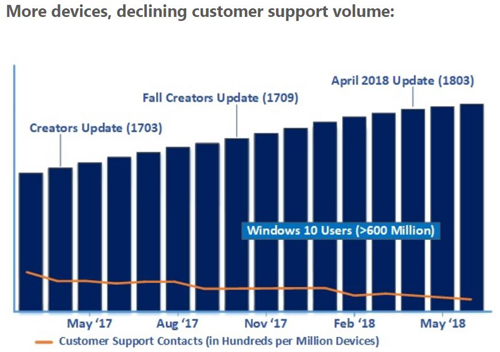News
Windows 10 April 2018 Update Now 'Fully Available'
Microsoft has declared the Windows 10 April 2018 release (version 1803) to be a successful one, at least in terms of its telemetry findings, and is now labeling the release as being "fully available."
The fully available term is a relatively new one in the ever-changing lexicon of Microsoft's Windows-as-a-Service update model. It first popped up with the Windows 10 "Creators Update" (version 1703) last year. Here's how John Cable, director of program management for Windows Servicing and Delivery, explained it for the Windows 10 April 2018 Update in Thursday's announcement:
Full availability is the final phase of our rollout process. You don't have to do anything to get the update; it will rollout automatically to you through Windows Update.
The Meaning of Full Availability
While some might think that the fully available declaration signifies that Windows 10 version 1803 has reached the "semiannual channel" (SAC) stage (which is the final rollout phase of Windows 10), Microsoft's Windows 10 release information table currently doesn't show such an SAC release. Only the SAC-T ("semiannual channel targeted") is shown. It was released on April 30.
Microsoft's John Wilcox recently argued that organizations had been waiting for SAC releases (formerly known as "current branch for business" releases) to deploy Windows 10 updates, but it was unnecessary to do so if the SAC-T worked well after testing. Organizations should go right ahead and deploy the SAC-T release in such cases, he suggested. He also inscrutably suggested that Microsoft is planning to drop the SAC-T term altogether.
Wilcox also had explained back then that Microsoft would have a "broadly available" release declaration after an SAC-T release. Possibly, broadly available has the same meaning as Cable's "fully available" term.
It's not clear if fully available has any real meaning for IT pros. It may be just a popping-of-the-corks kind of thing up in Redmond.
For some users, the arrival of Windows 10 version 1803 resulted in Remote Desktop Protocol issues, bricked Intel SSD6 drives and black screens when using Avast anti-virus. In contrast, Cable depicted the Windows 10 version 1803 SAC-T launch as a successful one. It elicited lower customer support requests than past Windows 10 releases, and is now on almost "700 million monthly active devices" (see chart).
 [Click on image for larger view.] Windows 10 version 1803 correlated with a greater volume of use but lower customer support requests. (Source: June 14 Microsoft blog.)
[Click on image for larger view.] Windows 10 version 1803 correlated with a greater volume of use but lower customer support requests. (Source: June 14 Microsoft blog.)
Cable attributed that success to Microsoft's artificial intelligence (AI) approach, which checks to see if machines are ready for new Windows 10 updates before they become available. He added that "the April 2018 Update is officially the fastest version of Windows 10 to reach 250 million devices, achieving that mark in less than half the time it took the Fall Creators Update!"
Windows Insider Testing Program
Microsoft has always urged IT pros to get involved with the Windows Insider Program, where early releases of Windows 10 become available for testing. It is supposed to give them an early opportunity to test how a Windows 10 update will affect their computing environments.
This week, Bruno Nowak of Microsoft suggested in an announcement that organizations should be using slow-ring Windows Insider releases of Windows 10 for "validating both apps and infrastructure." Microsoft's general argument is that it is giving organizations "smaller, more manageable updates" with Windows 10, which is considered to be a benefit, rather than a testing burden for IT pros.
Microsoft plans to answer questions about Windows Insider previews and its testing approach recommendations for IT pros in a 24-hour Windows 10 "Ask Microsoft Anything" online session on Tuesday, June 26, starting at 10:00 a.m. PST. The engineering team will answer questions live on June 27 from 9:00 a.m. to 10:00 a.m. PST.
About the Author
Kurt Mackie is senior news producer for 1105 Media's Converge360 group.